The long-awaited book The Nature of Middle-earth, published by Houghton Mifflin Harcourt, has newly awakened into the world like Quendi by the shores of Lake Cuiviénen! Fans hungry for more Middle-earth are scooping up their copies and… making Aragorn beard-memes? Just what is this new posthumous Tolkien book exactly, how “canon” is it, and what things do we learn about J.R.R.’s legendarium that we didn’t know before? Here is everything you need to know…
Fans of The Hobbit and The Lord of the Rings who aren’t much into Tolkien’s other Middle-earth stories may only find a few curiosities here. Answers to burning questions like: Were there any ursine entertainers on Númenor? Could Legolas talk to horses? Who in the Fellowship actually had facial hair? Come 5 o’clock, did a shadow gather about Aragorn’s cheeks and chin? Did Gollum actually go about buck naked? Was Galadriel a natural blonde? CELEBORN TELLS ALL!
Okay, not that last bit. Celeborn is still the Celeborn we know and love and still, as mentioned in Unfinished Tales, considered the grandson of Elmo, brother of Thingol. And that’s all that can possibly be said about that relative: “a shadowy figure about whom nothing is told” beyond his place in the family tree. Elmo.
The truth is, the vast majority of this book is rich textual ore worth mining… mostly for appreciators of The Silmarillion and the books beyond. In fact, you’d need some familiarity with the Elder Days to relish the new details. It’s an uber-nerdy deep cut, is what I’m saying. The Nature of Middle-earth, edited by NASA computer scientist (you read that right) Carl F. Hostetter, is kind of an unofficial thirteenth installment of the 12-volume History of Middle-earth (HoMe). The last volume of HoMe, The Peoples of Middle-earth, came out 25 years ago! So getting anything new from Tolkien that wasn’t published before is a big deal.
This book’s kind of like an FAQ for all the fans who’ve cropped up in all those years asking still-unanswered questions. It’s like someone important demanded, “So can Elves have beards or what? Círdan the Shipwright sure did—was he some kind of freak?” It’s like a Tolkien-Signal went up, and the powers that be answered the call.
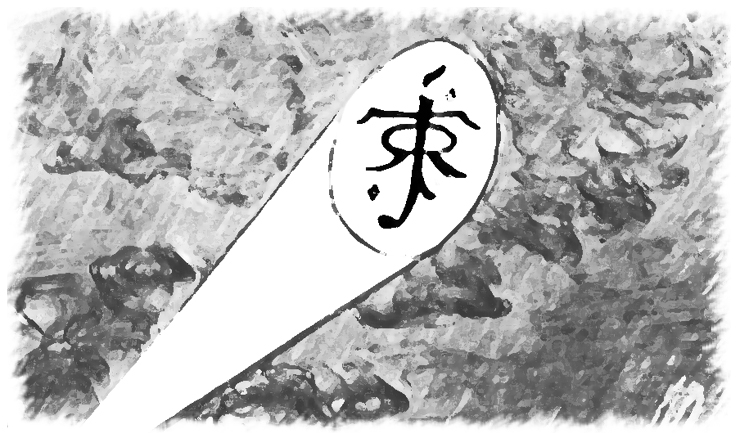
But of course, that’s not at all why it’s come to be. As Hostetter explains in the foreword, many years ago he was sent “a bundle of photocopies of various manuscripts and typescript materials” of “late philological essays” by Christopher Tolkien, having made his acquaintance through his work in the Elvish Linguistic Fellowship (E.L.F.)—a real and exceptionally nerdy international organization I wish I had half the brain power to join. Through Hostetter’s treatment of Tolkien’s invented languages, he’d earned Christopher’s trust and approval. To say the least. And this book is the assembly of that linguistic information and what new legendarium lore is revealed in its exploration. If there is a coherent theme to this scattered information, it’s reflected in the title itself, The Nature of Middle-earth, as Hostetter explains:
Among the chief “structural” conceptions of the mythology that he pondered in those years were the myth of Light; the nature of Aman; the immortality (and death) of the Elves; the mode of their reincarnation; the Fall of Men and the length of their early history; the origin of the Orcs; and above all, the power and significance of Melkor-Morgoth, which was enlarged to become the ground and source of the corruption of Arda.
Unsurprisingly, Tolkien’s primary motivation was the working out of his languages, the Elvish nomenclature that was his true passion—and if, in so doing, more world-building details of Middle-earth were revealed in evocative new ways, well then, so be it. For example, it’s while Tolkien is describing some Elvish words for hands and fingers that he drops, almost like an afterthought not worth mentioning anywhere else, that Elves are all ambidextrous! That there is no “general inherited racial habit” involved, which makes sense, if you’ve read in Morgoth’s Ring about the amount of control an Elf’s fëa (or spirit) has over her hröa (body).
It’s worth remembering that these are essays and incomplete notes Tolkien wrote for himself, not exactly sorted for wide readership (though Hostetter does an excellent job organizing them for us). Tolkien was always trying to work out the innumerable fine points of his world as well as its key theological components. Reading The Nature of Middle-earth and Unfinished Tales and the HoMe books is basically us rifling through Tolkien’s old notebooks intended for the epic D&D campaigns he never really got to run because he was constantly sidetracked by the particulars of his Elvish languages. Each passage is really only one snapshot from a certain moment in time. Tolkien changed his mind a lot. Some of these writings come from the late 1950s, when The Return of the King still had that new masterpiece smell, while others came about in the last years of his life, after he’d had more time to reflect and start retconning.
As to what we learn in this book that’s new—well, it’s actually a heck of a lot! I can’t dish out everything, or even properly summarize it, because no one says any of it better than the man himself. This book is worth reading, if you’re even a little bit invested in Middle-earth beyond the pages of The Lord of the Rings. The wonderful cover art, taken from “The Light of Valinor on the Western Sea,” by the inestimable Ted Nasmith, depicts not Middle-earth itself, ironically, but the shores of Aman (a separate continent from Middle-earth), the very place those legendary Elf-ships sail to when they go into the West.
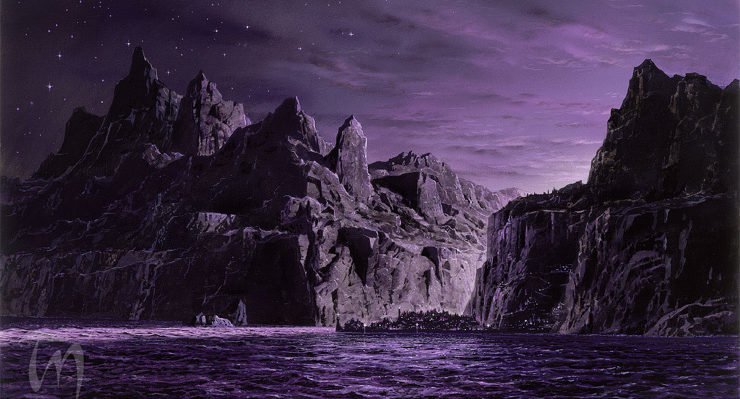
In case you aren’t familiar with any of the History of Middle-earth books but are still curious about this one anyway, here are some terms you can refer back to, as they do come up a lot (skip this for now if you know these things).
- Ainur – the “offspring of Ilúvatar’s thought,” the spiritual beings that existed before the universe was even a thing; they include the Valar and the Maiar
- Aman – the Blessed Realm, a continent far west of Middle-earth across the Great Sea; includes the land of Valinor
- Arda – the planet or solar system of which Aman and Middle-earth are but two continents
- Avari – the Unwilling, those Elves who declined the summons to Valinor and remained on Middle-earth from the start
- Children of Ilúvatar – Elves (the Firstborn, who will live as long as Arda) and Men (the Secondborn who, being mortal, will die and leave Arda)
- Cuiviénen – the lake upon whose shores the Elves first awoke
- Eldar – the firstborn Children of Ilúvatar, the people of the stars; sometimes the term refer to all Elves, but usually refers only to those (majority) of Elves who accepted the invitation to Valinor
- fëar – Quenya term for spirit or soul
- Great March – the long journey of the Eldar to Valinor; many lingered and remained in Middle-earth, while others (the Noldor, the Vanyar, and some Teleri) crossed the Sea
- hröar – Quenya term for body
- Ilúvatar – Eru, the One, the central God of everything
- Maiar – the spirits (Ainur) who entered Arda to assist the Valar
- Manwë –the King of the Valar, master of the winds and airs of Arda
- Noldor – one of the three kindreds of Elves, a significant percentage of them later went into exile and returned to Middle-earth
- Olórin – the Maia who will someday be known as Gandalf, Mithrandir, etc.
- Oromë – the forest- and hunter-flavored Vala who discovered the Elves and was the one to lead them on their Great March
- Quendi – general term for all Elves, “those who speak with voices”
- Quenya – the Elvish language devised by the Noldor
- Sindarin – the Elvish language devised by the Sindar (formerly the Teleri), who came from the Teleri
- Teleri / Sindar – one of the three kindreds of the Elves; only some crossed the Sea, but most remained on Middle-earth and became the Sindar
- Two Trees of Valinor – situated in Valinor, a powerful source of light power; eventually destroyed by Melkor and Ungoliant
- Valar – the Powers, the mightiest of the Ainur who volunteered to govern Arda
- Valinor – the realm of the Valar, in Aman
- Varda – the Queen of the Valar, kindler of the stars
Now, let’s look at some examples and talk about some of the important revelations in the book. Hostetter divides The Nature of Middle-earth into three parts, so let’s see what each offers.
Part One: Time and Aging
These chapters provide a ton of crunchy numbers for math nerds, but also a lot more possibilities and insight into the early years* of the Elves, their discovery by the Valar, the summons to Aman, and the apparently-generations-spanning Great March—that is, the long trek that the Elves began from the place they first awoke all the way to the western shores of Middle-earth and across the Great Sea.
* I asterisk years because there are Valian years (measured by the waxing, waning, and mingling of the lights of the Two Trees of Valinor) and then there are sun-years (mortal years measured by the cycles of the Sun†). And we can see in this book that by 1957, Tolkien extended his idea that 1 Valian year = 10 sun-years should be changed to 1 Valian year = 144 sun-years. Suddenly a lot of gaps in time are multiplied by 14.
† Why the dagger? Why would we measure anything in sun-time before the arrival of the Sun, which, according to the published Silmarillion, did not happen until the time of the awakening of Men just after the exiled Noldor return to Middle-earth. But Tolkien wasn’t truly satisfied with that, as we’ve read before in Morgoth’s Ring. He wanted to rework his cosmological ideas for better compatibility with scientific facts. But that would take a lot of rejiggering…more than he had time for.
In any case, much of the new text here assumes that the Sun had always been around, after all, and when the Elves first awoke to the sight of the stars in the heavens, it was simply nighttime. They would see a dawn, in this case, but they would always love stars the most. And their maker, Varda, a.k.a Elbereth Gilthoniel.
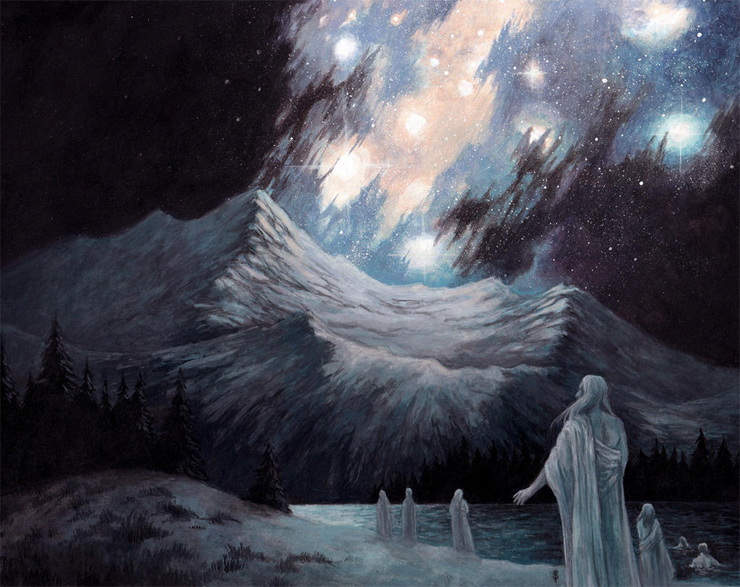
Beyond solar concerns, we are also presented with new possibilities that would throw a wrench into various chronologies of The Silmarillion. If Melkor was to bring about the Fall of Men, as Tolkien seems to have intended, it would have to be shortly after their awakening on Middle-earth, in which case this would have to take place before he is dragged out of his fortress of Utumno and imprisoned in the Halls of Mandos. But if that’s way too soon, then Men would have to awaken during his time of captivity—in which case, the fall would have to be “achieved not by Melkor in person, but by Sauron.” This gives rise to so many unexplored implications!
As for the awakening of the Elves, we get one fable-flavored tradition, which Tolkien devised while reworking his numbers “to reduce the number of weddings (and thus begetting) of the Eldar on the March.” Here, only three male Elves first awake, fully grown, each beside his “destined” mate.
Then they were so enamoured of their beauty that their desire for speech was immediately quickened and they began “to think of words” to speak and sing in. And being impatient they could not wait but woke up their spouses. Thus (say the Eldar) elf-women ever after reached maturity sooner than elf-men; for it had been intended that they should wake later than their spouses.
Those six Elves soon left the hollow where they’d awakened, and on the next night found another twelve Elves nearby. As more were discovered, in other dells and beneath a waterfall, each of the original three “elf-men” chose a subset of companions who would eventually become the known kindreds (Noldor, Vanyar, Teleri); “as yet they had no formed speech, though they sang sweetly and their voices echoed in the stone, mingling with the rush of the falls.” Thus, one hundred forty-four mature Elves were awakened in total (seventy-two destined couples), all considered the First Elves.
Alas, Tolkien does not ruminate on the question of whether the First Elves had belly buttons.
Here is one morsel I can’t decide how to feel about: So Oromë is still the one who finds the Elves. Cool, same as before. And when he goes back to tell the other Valar, Manwë their king makes the fateful decision to bring the Elves to Valinor. Right. But we also learn that it was on Varda’s insistence that the summons should be invitation only. Good on you, Varda. There’ll be no arm-twisting the Elves. Free will is important. But while the Valar prepare for war against Melkor, who they still wish to remove from Middle-earth, they decide to send several “great spirits of the Maiar” to guard the Elves in the meantime. Who goes? Why, Melian (“the only woman, but the chief”) and the five who will someday be the Istari.
On the one hand, of course this is fascinating: a much-younger Gandalf hanging out with the early Elves! Right on! On the other, does it feel right? Do the Gandalf and Saruman we meet in The Lord of the Rings really feel like they were involved in such times? Sure, Olórin’s memory of his days in Valinor become cloudy after he goes to Middle-earth in the Third Age. We can try to justify it, but I have to say, it’s still a rather lofty retcon—and it makes the world of Middle-earth feel a little bit smaller, where everyone knows everyone from way back, like Yoda and Chewbacca, C3-PO and Anakin, et al. It also doesn’t smoothly jibe with the “Istari” chapter in Unfinished Tales, where a council of Valar asks, “Who would go? For they must be mighty, peers of Sauron, but must forgo might,” and so on, and yet no one says: “How about the same fab five that Melian took to Cuiviénen?”
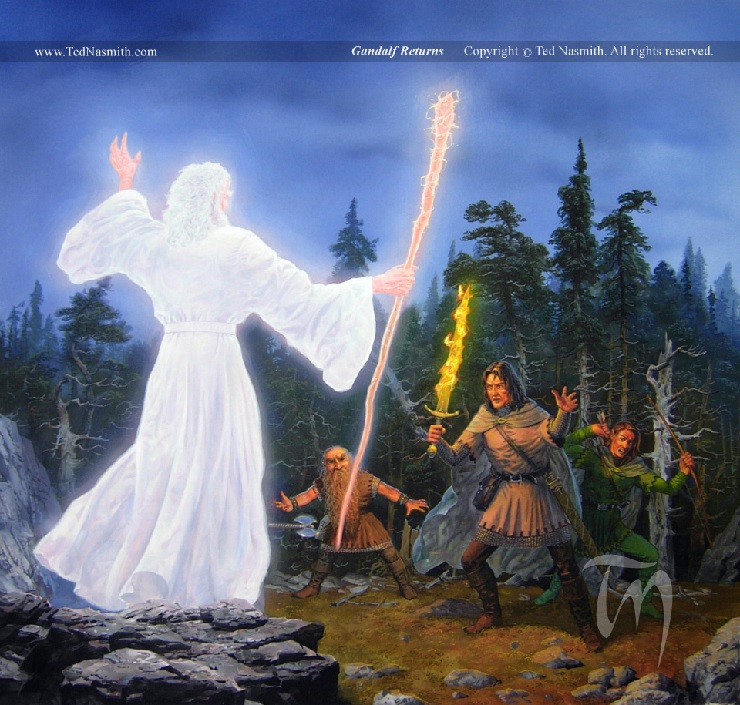
In any case, on account of the new year measurements (the 1 Valian year = 144 sun-years), time according to The Nature of Middle-earth stretches out into truly vast amounts, allowing for the Eldar to dawdle and tarry a heck of a lot more than we had previously supposed as they follow Oromë across the sprawling lands of Middle-earth. Lots of stopping and starting for hunting, fur-curing, cloth-making, marrying, and children-having. The Elves were multiplying as they went. And they do not journey with infants; Tolkien is clear on that point. The youngest generation must reach at least 120 sun-years in age before the March resumes.
Oh yes, and while there are no concrete populations given, we can get a pretty good idea of what Tolkien was thinking. In one example, he supposed that 20,000 of the Eldar started the March, leaving about 9,000 Avari (those who didn’t March) behind. These are just starting numbers, and the population increases as time rolls on.
We also get these little nuggets which are entirely new (to us), speaking of the March:
In spring and summer of VY 1130/15 it only moves 200 miles (650 total). It camps in what are the wide grasslands before Mirkwood is reached, and full of grain and food. The Elves taught by Oromë sow grain that autumn, and reap in summer of 1130/16. They do this three times till 1130/19 and do not move on till spring 1130/20.
Agriculture, at last! More about that later.
Honestly, this whole first third of the book would be the perfect source material for my dream game: The March of the Eldar, which would look and feel just like The Oregon Trail (including 8-bit graphics), but instead of dying of dysentery (Elves can’t get sick!) or a broken wheel axle, your Elf’s caravan has other obstacles to contend with: the profound beauty of a starlit glade, a riverside in need of acclimation, the discovery of a new species of plant that needs thoughtful naming, and of course the numerous ambushes by various monsters of Melkor’s corrupting. At the start of the game, you’d get to choose which of the three kindreds you’re part of: the fair and eager Vanyar, the industrious Noldor, or the straggling Teleri (who, above all, desire to tarry).
Let me have this, please.
There is also greater confirmation that Tolkien regarded the Elves not as perfect, but closer to what mortals might have been like had they not fallen to evil as a people.
The Quendi never “fell” as a race – not in the sense in which they and Men themselves believed that the Second Children had “fallen.” Being “tainted” with the Marring (which affected all the “flesh of Arda” from which their hröar were derived and nourished), and having also come under the Shadow of Melkor before their Finding and rescue, they could individually do wrong. But they never (not even the wrong-doers) rejected Eru, nor worshipped either Melkor or Sauron as a god – neither individually or as a whole people.
Part Two: Body, Mind and Spirit
Those put off by Tolkien’s math-talk can jump right over to this section, which is chock-full of other goodies. As always, some of the best lore is merely runoff from Tolkien’s linguistic explorations. Moreover, some of the more enthralling pieces are drawn from narratives still subject to change. For example, in the chapter “Eldarin Hands, Fingers, and Numerals,” we find out that Celebrimbor is a Sindarin name (as opposed to Quenya, the language of the Noldorin Elves), meaning ‘Silver-fist,’ and was evidently a common name among the Telerin Elves because they were also excellent silver-smiths. Cool. Then, suddenly:
The famous Celebrimbor, heroic defender of Eregion in the Second-age war against Sauron, was a Teler, one of the three Teleri who accompanied Celeborn into Exile.
Wait, what? Celebrimbor is the Elf who forged the Three Rings! In later writings, Tolkien tied up his origin quite differently, making him the grandson of Fëanor (of Silmaril-making fame) and very much one of the Noldor. Given how powerful the Silmarils were, it makes more sense that Celebrimbor’s mad skillz would be up to the task of singlehandedly creating Vilya, Narya, and Nenya. But hey, in that same chapter, we get the Quenya names for fingers and toes. And among children, they have play-meanings: ‘daddy,’ ‘mummy,’ ‘sticker-up’ or ‘big boy,’ ‘girl’ (‘daughter’), ‘baby.’
Which makes me wonder, do young Elves pinky swear (‘baby-swear’?), too? Probably; they have to start practicing their ominous, doom-laden oaths sometime!
Beards get their own little chapter. We’re told that “the Elvish race had no beards,” so even among Men if there was an Elvish strain in the blood (as in the royal house of Númenor), those guys wouldn’t need to buy razors at all. Tolkien refers to a letter he wrote when he was asked about which male characters had beards.
I replied that I myself imagined Aragorn, Denethor, Imrahil, Boromir, Faramir as beardless. This, I said, I supposed not to be due to any custom of shaving, but of a racial characteristic. None of the Eldar had any beards, and this was a general racial characteristic of all Elves in my “world.”
We know that this rule cannot apply completely. Círdan the Shipwright is famously described as having a beard (and a long one at that) at the end of The Return of the King. That explanation requires a look elsewhere, though—to the linguistic journal Vinyar Tengwar (that Hostetter also worked on), where it’s mentioned that Elves have life cycles, and not “until they entered their third cycle” did facial hair appear. So apparently only real old-timers like Círdan, that jolly old Elf, might grow whiskers… and possibly set up as Father Christmas figures for Middle-earth? Just guessing.
Speaking of appearances, Hostetter provides some quotes from Tolkien on descriptions of some of the LotR characters, mostly in reaction to the very cool map poster that his publisher, Allen & Unwin, printed in 1970. He liked much of it, but called out the things he didn’t. Some fun takeaways, to me, are:
- That Gandalf, who would be shorter than usually depicted and more stooped by age, had “more knowledge of beasts and birds” than Radagast!
- That Gollum certainly wore clothes (whoever said he didn’t?!), presumably much more than a loincloth; it certainly had to have pockets, and made his overall appearance quite dark. I knew it! Also, he had prehensile toes! Freaky.
There are several chapters about the nature of the Elvish mind, of memory, and of the active (if quiet) “thinking” state Elves enter when they sleep. In the chapter “Ósanwe-kenta,” which was originally published “in a slightly different form” in Vinyar Tengwar, we learn about the power of “thought-transmission” that beings like the Valar and the Eldar possess (and to a much lesser extent, Men). It is essentially mind-to-mind contact, a kind of telepathy. In The Lord of the Rings, whenever the Wise seem to speak to one another without words like Gandalf and Celeborn and Galadriel in Book 6, Chapter 6: “Many Partings,” we might suppose this to be ósanwe, or “interchange of thought.”
For they did not move or speak with mouth, looking from mind to mind; and only their shining eyes stirred and kindled as their thoughts went to and fro.
But frankly, the applications and possibilities of ósanwe are a better topic for a deep-dive of its own someday. It is not this day. Same with the complexities of fate and free will and Eldarin philosophy, which sees a lot more linguistic exploration in this book.
One thing I would like to call special attention to is the discussion of fanar (‘veil’), the name given to the “raiment” in which the the Ainur (the Valar and the Maiar) clothed themselves when they wished to interact with the Children of Ilúvatar. These are their physical forms, perceivable, capable of being touched and of casting shadows. The Valar have powerful mastery over the “physical material of Eä (the material universe)” and so they would assume these solid bodies “out of love for the ‘Children of Eru,’ the Incarnate, whom they were to guard and counsel.” Thus in The Silmarillion we get some descriptions of the Valar, like how Yavanna, the Giver of Fruits, is “tall, and robed in green,” or of Tulkas, whose “hair and beard are golden, and his flesh ruddy.”
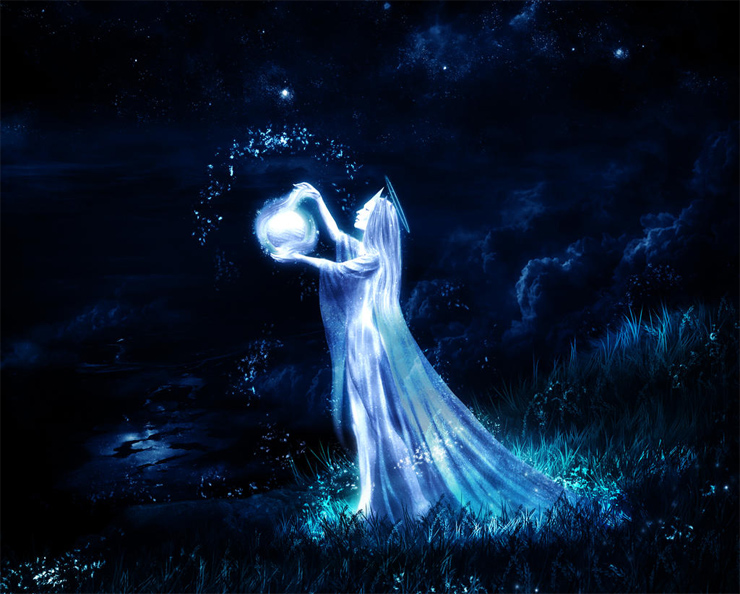
And regarding the physical size assumed by the Valar, Tolkien never gives us measurements but he does give us this:
The fanar of the great Valar were said by the Eldar who had dwelt in Valinor usually to have a stature far greater than that of the tallest Elves, and when performing some great deed or rite, or issuing commands, to have assumed an awe-inspiring height.
The average full-grown Elf is six and a half feet tall, and we know the tallest Elf ever named was Thingol (a.k.a. Elwë, one of the Ambassadors on the Great March), who seems to have been seven feet or more. So “far greater” than that does paint a towering picture. However:
In these forms they presented themselves to the Elves (though they could assume other and wholly alien shapes), appearing usually as persons of majestic (but not gigantic) stature.
So somewhere between awe-inspiring and not gigantic. Got it. But the real gem in this chapter can be found in how the evil of Melkor and his fallen Maiar have some different rules. It starts with this.
But the Elves of Valinor asserted that unclad and unveiled the Valar were perceived by some among them as lights (of different hues) which their eyes could not tolerate; whereas the Maiar were usually invisibly unclad, but their presence was revealed by their fragrance.*
Whereupon Tolkien added a footnote (I swear, the best stuff is in footnotes):
* This applied only to those uncorrupted. Melkor, as they said, was invisible, and his presence was revealed only by great dread and by a darkness that dimmed or blotted out the light and hues of all things near him. The Maiar corrupted by him stank. For this reason neither he nor any of the evil Maiar ever approached one of the Eldar that they wished to persuade or deceive except clad in their fanar.
That is, the various demons and other Maiar spirits who gathered about their boss in Utumno and Angband. Crack open a window, will ya! But okay, so it’s just their “unclad” selves that were necessarily malodorous (as if we needed more proof that Morgoth’s fortresses were stinky). But we’re not done yet. Speaking of the physical fanar of evil Maiar…
These they could still make to appear beautiful to Elvish eyes, if they wished—until after the great treachery of Melkor and the destruction of the Trees. After that Melkor (Morgoth) and his servants were perceived as forms of evil and enemies undisguised.
Here, then, it is explicitly stated what The Silmarillion addresses only briefly in Chapter 8, “Of the Darkening of Valinor.” When Morgoth went to recruit Ungoliant for his attack on Valinor, he “put on again the form that he had worn as the tyrant of Utumno: a dark Lord, tall and terrible. In that form he remained ever after.” Because when he and Ungoliant tag-teamed the demise of the Two Trees, Morgoth squandered too much of his own power to be able to change out his chosen fana for another. Granted, this body is scary as hell. Perfect for commanding monsters and intimidating captives. But it’s permanent, is my point. All sales final for Morgoth!
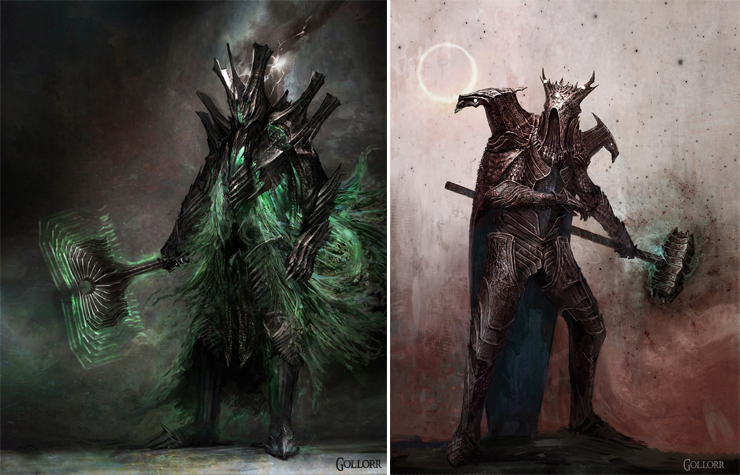
Unable to go around spirit-like anymore, Morgoth settled into retirement in Angband to do whatever damage he could from there. He makes his “great crown of iron,” places the stolen Silmarils in it, then broods on his dark throne for all future endeavors and schemes—not handsome, not fair, not seductive (those days are behind him now), not to mention in constant pain. There is a lot of fan art out there showing a wispy, pretty-boy Elf wearing a crown beset with Silmarils. Some of them are impressive, no question—but they disregard Tolkien’s canon. Morgoth, by the time he’s wearing that crown, has been an ugly mofo since his terrible date with Ungoliant. In the very least, he should be terrifying to behold.
What about Sauron, though? He’s a Maia. He is certainly a special case, since we know from his Second Age plots that he assumes the disguise of Annatar, Lord of Gifts, which he put to good use in that whole Rings of Power move. And if—as Tolkien suggested he might—Sauron had been the one to “achieve” the fall of mortal Men so long before, and yet hadn’t spent his own native power the way Morgoth did, it’s plausible that he could still assume a deceiving shape and appear beautiful, even with his fanar.
That is, until the sinking of Númenor, when Sauron, too, lost the ability to ever appear fair again. We’re specifically told this in The Silmarillion as well. Yet he did fly all spirit-like out of that watery abyss and take physical shape again, “an image of malice and hatred made visible.”
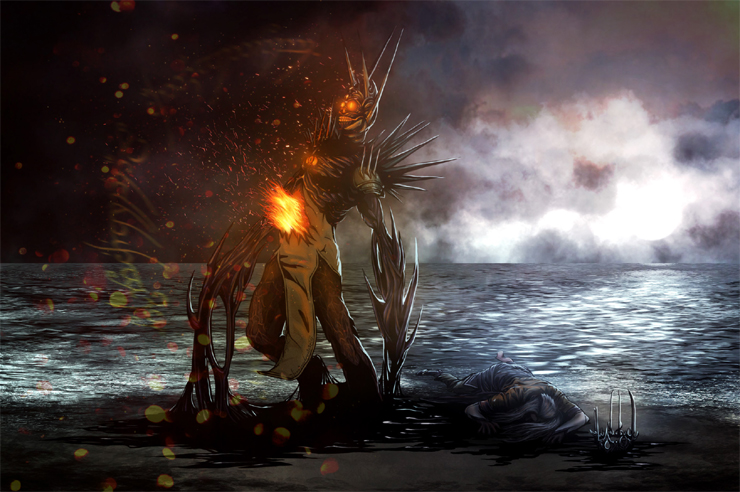
There are also essays on Elvish reincarnation and the nature of their spirits as created by Ilúvatar alone. There is even a chapter on how the death of animals (kelvar) and plants (olvar) were regarded by the Eldar (in a bittersweet fashion). For their part, the hröar (bodies) of the Elves do not perish swiftly even when slain. They weren’t meant to be destroyed at all, but the marring of the world by Melkor changed things. Even so, an Elf’s lifeless body “will wait much longer, maintaining coherence and resisting decay, but then it will usually seem to sleep, lying passive and essaying nothing.” Were the same body available in Valinor, it might well be restored and reinvested with the fëa (spirit) that had inhabited it originally. Whereas the hröar of Men, once ousted by force or age, departs the world anyway. With no further purpose, the body “passes away into Arda.”
Part Three: The World, Its Lands, and Its Inhabitants
Here we read more of Tolkien’s post-Rings cosmological ideas, such as not having the Sun and Moon made from the fruit and flowers of the Two Trees but having existed all along. It was a matter, Hostetter asserts, “that Tolkien never resolved: namely, how to incorporate this scientific truth into his mythology without eviscerating its distinctives.”
Yet herein we’re presented with considerations and even little drawings—all, as usual, spawning from Elvish words he was tooling around with, and in this case those involving darkness and light. Like the word fuin (seen in words like Taur-nu-Fuin), which means ‘night’ and wasn’t even seen as an evil thing at first. In fact, it was regarded by the Elves as a “‘breath’ that came out of the East as the Sun went down in the West, which brought a cool shadow that grew ever darker.” But this also implies the early Elves were acquainted with the Sun, a distinction from the published Silmarillion.
Even before their first acquaintance with the Valar they had evidently constructed a picture mytho-astronomical of the world, which was in some respects far nearer to our recent knowledge and theory than might be expected. This “picture” endured in their minds and coloured their myths even after the learned and most scientific among the High-elves who dwelt with the Valar had, or so it may perhaps be presumed, learnt far more the scientific truth (or what we now regard as the truth).
So there are no flat-earthers among even the Elves in this take. Arda was the whole Solar System, encompassing the Earth, the Sun, and Moon in this model, plus some “wayward stars,” and was meant to be the home of the Children of Ilúvatar. But even the planet itself was seen as spheroid (in fact, oblate) with a “deep circular chan[nel]” cut through it making the East, West, North, and South poles inaccessible to “terrestrial animals, nor Elves or Men, without wings.” Still, these models are mere fragments, and it’s little wonder why Christopher Tolkien fully embraced the more thoroughly realized earlier cosmology of Arda in The Silmarillion.
Moving on, we get a bit more about the special “waybread” of Lothlórien fame but which Tolkien casts much further back in time. Not only was lembas the gift of Manwë and Varda to the Eldar on the Great Journey by way of Oromë, we finally get some serious talk about Elves and agriculture! It’s hard to explain how exciting the prospect of Elven economics is unless you’ve been a Tolkien fan for a long time. Sadly, the information here is scattered and still suffers from the inconsistencies of Tolkien’s unpublished-during-his-lifetime brainstorms. Still just notes to himself. He’s not exactly parsing it all out carefully for us.
At least it’s confirmed that Elves dabbled in agriculture in their early days, before the Great March, and only after Oromë showed up did they level up their farm skills. There’s also talk of the Sindar who dwelled outside the boundaries of the Girdle of Melian “grain-growing,” “cattle-rearing,” and “sheep-farming,” and profiting because they could trade with both Doriath to the west and the Dwarves of the Blue Mountains to the east. And speaking of Dwarves…
The Dwarves had an agriculture – which in early times they practiced when isolated and unable to buy grain etc. by barter. They had invented a “plough” of some sort – which they dragged as well as steered themselves: they were tough and strong – but they did not delight in such labour of necessity.
Hah! Who needs an ox when you’ve got Dwarves? I think this means that not only did they farm (when they had no other choice), some of them probably grumbled about it. Further chapters in this part of the book talk about how awesome Elves were at horse-riding (because of course they were); the type of homes the Eldar made in Beleriand, especially the Sindar (“permanent built dwellings were rare,” because they were “accustomed to a nomadic mobile life”), with the exception of places like Menegroth and Gondolin; and how they shored up defensively more when Morgoth returned to Middle-earth, especially once they made the acquaintance of the Dwarves of the Blue Mountains.
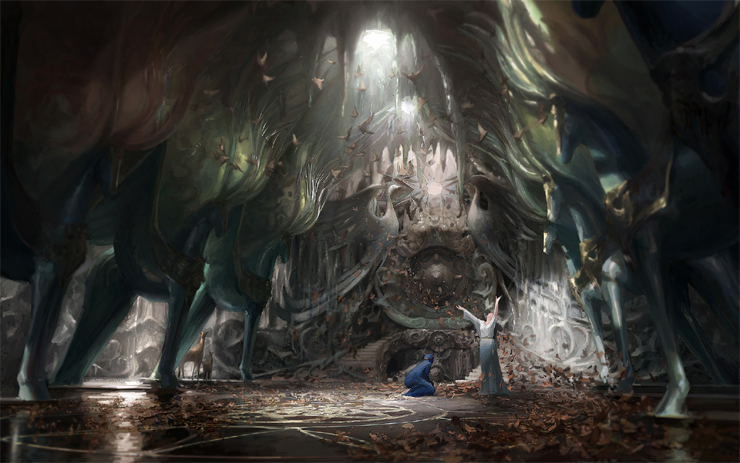
As always, all of these wonderful details are presented secondarily to the roots and structure of related Elvish words. Because c’mon, people! Philology first! I mean, duh.
The founding of Nargothrond gets its own little chapter, in which we’re reminded that Finrod Felagund was the best Elf ever. Well, maybe not explicitly, but it does again call out that he “was the wisest and most farseeing of the chieftains of the Noldor,” and so he spent a lot of effort personally searching the lands and scouting out the right place to build his hidden fortress. In this, he had the help of the Dwarves. Curiously, there’s no mention of the Dwarves of the Blue Mountains, who in the published Silmarillion are the ones to help Finrod build up Nargothrond (even though it’s later established that the Petty Dwarves were the ones who had carved tunnels there first). In fact, in this version we’re told that some Petty Dwarves still lingered at the site.
In this labour he had at first help from the Petty Dwarves and their feigned friendship; for which he rewarded them generously until Mîm their chieftain made an attempt to murder him in his sleep and was driven out into the world.
Oooof. Bad Mîm! You don’t get a more stand-up guy than Finrod. As far as I know, this assassination attempt was never mentioned anywhere before, and yet it’s such a throwaway line on Tolkien’s part. GAH. That could be a whole story of its own! Was Finrod even awakened in the deed? Did he know? Were any of the Dwarves of the Blue Mountains nearby? They hated the Petty Dwarves. Knowing Finrod, he probably pitied Mîm and forgave him, called off any hunt, understanding that the sulking old Dwarf wouldn’t dare to come back—or, being farseeing as he was, maybe Finrod figured that Mîm had “some part to play yet, for good or ill, before the end.” Which, if you’ve read the story of Túrin Turambar… he does.
We see more explicit talk about the erring or possible erring (depending on who you ask, it seems) of the Valar—not only regarding their Eldar summoning but also the ban later imposed on the Noldor after they rebelled. In the chapter “Manwë’s Bane,” a subtle but excellent point is made. See, it’s easy to blame Fëanor and his followers (and before them, Melkor for his manipulations) for all the “hideous deeds of robbery and bloodshed and treachery” that took place during that exodus,
Then a large number of the Ñoldor, who had taken no part in this, went back to Valinor, and sought pardon and were granted it. Those that did not do so, even if not personally slayers, must share the blood guilt, if they accepted the freedom gained by it. That none of the Ñoldor should be allowed again to dwell in bodily form was an inevitable consequence. That none of the Valar or Maiar should appear in their lands to aid them was also inevitable.
If they accepted the freedom gained by it. Hence in The Silmarillion there is a guilty silence that broods around even the more stand-up Noldor like Finrod and Galadriel whenever their Sindar friends started asking questions the whole leaving Valinor thing.
A considerable amount of detail is given about Númenor, the lifespans and heritage of its people, and the geography of the island itself. But more important, of its animals! Beasts were, on the whole, friendlier to Men there than anywhere in the world. Even “those that the Númenóreans classed as ‘predatory’… remained on ‘honourable terms’” with them. Plenty inhabited the island before the Edain first arrived there, but the Men brought some with them, like dogs! And no surprise: the most hostile of the island’s native species were cats. Lots of foxes, though, and they preyed on a rabbit-like species called the lopoldi (but people didn’t eat them). Bears were abundant and “[a]t no time was there any hostility between Men and bears,” and in fact…
They never dwelt in or near the homes of Men, but they would often visit them, in the casual manner of one householder calling upon another. At such times they were often offered honey, to their delight. Only an occasional ‘bad bear’ ever raided the tame hives. Most strange of all were the bear-dances.
Oh, there is more about that bear-dancing, and you should totally read it. There’s talk of badgers, and swine, and deer, and seals, and horses, and turtles. And squirrels! Especially the dark brown and black squirrels that apparently Númenórean women were “specially fond of.” And much more! It’s like Númenor’s answer to the Galápagos Islands over here, in land, sea, and sky. Which should be no surprise: the island itself was raised up out of the sea by Ossë, made firm by Aulë, and “enriched” by Yavanna.
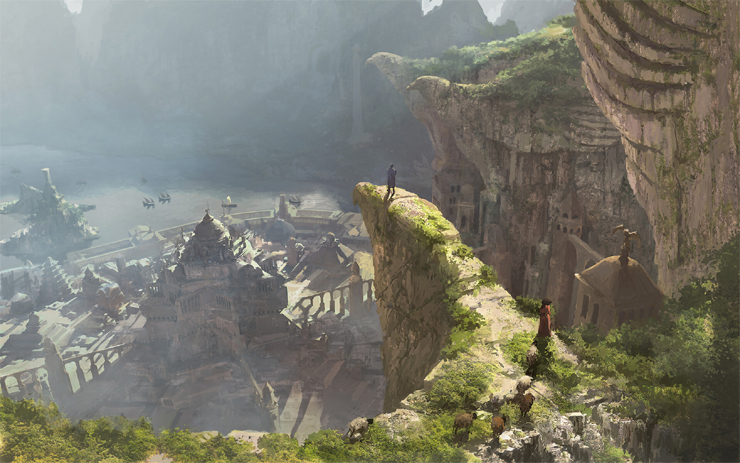
But come on, how awesome is all this? I didn’t think the eventual sinking of Númenor due to the hubris of its people (and the true wickedness of its latter-day kings) could be more tragic. But now we see what else was lost.
There’s even a discussion of the original voyage of the Edain from Middle-earth to the island, and how many ships it must have taken. Tolkien is guessing, as he often does, being coy in his language as though he is relating various accounts, not devising it himself. The fleet of Elros might have been 150 ships, or as many as 300. Who really knows? The entire migration process probably took 50 years or more, totalling some 350,000 people. When you read The Silmarillion, it’s impossible to have even guessed this many. In the wake of each war, especially one like the War of Wrath, we usually think there’s some just remnant left of any given people.
So what remains? A bit of miscellany. A short treatise on who ate mushrooms; the movements and lands of Silvan Elves (the Wood-elves of The Hobbit fame); more wordage for Galadriel and Celeborn’s tangled past; and more insight into Second Age politics. Especially on the matter of Gil-galad vs. Sauron. See, when Sauron forged the One Ring in the year 1600, his identity and evil intentions were revealed to the Elves. This we already knew this from both The Lord of the Rings and The Silmarillion. But there’s more to it now, as presented in the chapter “Note on the Delay of Gil-galad and the Númenóreans.”
Why, Tolkien ponders, didn’t Gil-galad, the last High King of the Nolder and leader of the Elves of Lindon, immediately go after Sauron at this point? Why did he wait so long for the Dark Lord to make the first move in open war? Because it’s true: In “Of the Rings of Power and the Third Age,” it seems like the moment Sauron puts on the One Ring, the Elves all immediately take theirs off in sudden fear. And then, in wrath for the failure of his plan, Sauron comes right after them. But no, not right away. In the Appendix “A Tale of Years,” it actually looks like this:
1600 Sauron forges the One Ring in Orodruin. He completes the Barad-dûr. Celebrimbor perceives the designs of Sauron.
1693 War of the Elves and Sauron begins. The Three Rings are hidden.
1695 Sauron’s forces invade Eriador. Gil-galad sends Elrond to Eregion.
See those gaps?
The answer is truly fascinating, because it reveals the limitations of Sauron and speaks to more metaphysical laws at work. The first answer, Tolkien tells us, is that “it was one of the successes of his cunning and deceits that they were unaware of his actual weakness.” Gil-galad had no real sense of how powerful Sauron was or, heck, even that Mordor was the base of his power. Exactly where would Gil-galad march in great numbers to go after him? Yet Sauron had banked way too much of his power on the Ring gambit to eliminate his Elf-problems; he was ill-equipped for war.
Sure, he had his Orcs breeding in the Misty Mountains and the Grey Mountains but hadn’t been able to put in the effort to fully dominate the lands of Men in the far east—where Morgoth once had. Not just because he couldn’t go there in person, but because in his “fair-seeming Annatar” get-up he was far less effective at exerting his Dark Lord power. He had emissaries there among the “multiplying tribes of eastern Men” but that wasn’t enough.
But until the [S.A.] 1600 he was still using the disguise of beneficent friend, and often journeyed at will in Eriador with few attendants, and so could not risk any rumour that he was gathering armies.
See that? He could have just been some rando that an ancestor of Barliman Butterbur might’ve passed on a country lane back in those days. Just some dude going down the road in a wagon like some wandering, friendly pilgrim. But as always, Tolkien is painfully scarce on detail!
Anyway, this is reminding us that up until the exact moment he finished making—and first slipped on—the One Ring, Sauron wasn’t yet revealed to be the Enemy. Before then, there had only been rumors of a growing Shadow; Celebrimbor and most of the Elves of Eriador hadn’t put two and two together. Except, possibly, Galadriel, Gil-galad, and Elrond, all shaking their heads in the corner like the smart kids that the cool kids weren’t listening to.
So yeah, pre-1600, there was only Annatar, Lord of Gifts, who went to Eregion and taught the Noldor living there powerful arts and crafts… and ringmaking.
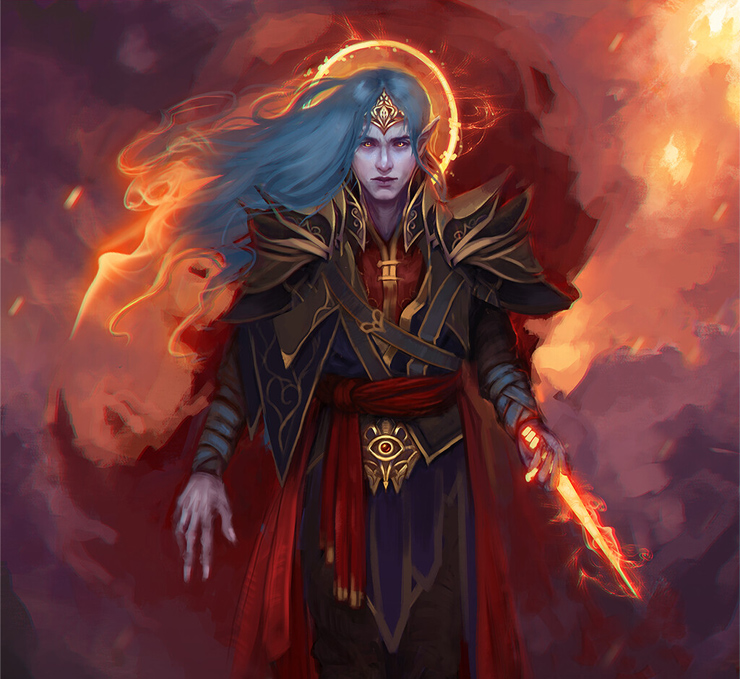
Now, remember that talk of fanar earlier, the “raiment” of the Ainur? Here Sauron has taken a charismatic fana, almost certainly Elf-like in form. But what’s really fascinating about this physical disguise is that he can’t just turn it on and off so quickly like a switch, at least not without consequence. This, I think, is new information.
In order to have a strong enough military to attack Eregion, he needed more Orcs than just those nearby; he needed the ones “further East” that were more numerous and “stronger kinds, descendants of Morgoth’s kingship,” but they were at this time “masterless.” These were unruly, fighting each other “and upon Men (whether good or evil).” There, by the way, is another of the precious few observations about Men in the East who are not evil.
But not until Mordor and the Barad-dûr were ready could he allow them to come out of hiding, while the Eastern Orcs, who had not experienced the power and terror of the Eldar, or the valour of the Edain, were not subservient to Sauron—while he was obliged for the cozening of Western Men and Elves to wear as fair a form and countenance as he could, they despised him and laughed at him.
Catch that? So long as Sauron was gaslighting the Elves as Annatar, he couldn’t also assert his power and authority over the Eastern Orcs. They laughed at him. But what Tolkien is saying here is, the moment he finally dropped the act (again, in 1600), “he exerted all his time and strength to gathering and training armies,” which literally took ninety years to do. THEN. Then came the War of the Elves and Sauron (1693), which had highs and lows for all involved. It eventually brought on the meddling of the Elves’ Númenórean allies (in 1700), so much so that Sauron had to book himself a gig on their little island (3262) just to put a stop to all that nonsense. Finally, it all culminated in the Battle of Dagorlad, where Gil-galad and Sauron finally got to square off beneath Mount Doom.
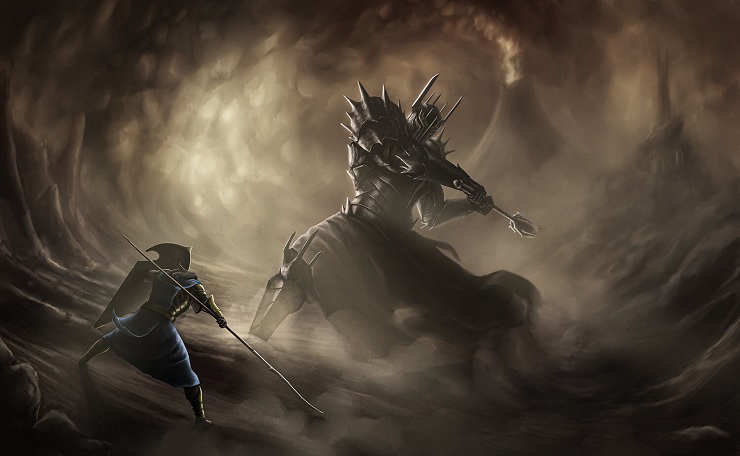
While I would have loved this data point when writing an article about Sauron’s power over Orcs, the truth is that it’s still more of a footnote. More about the limitations of Maiar (and arguably one of the mightiest) who have fallen into evil than about what it means to hold the mantle of Dark Lord.
Going back to cosmology, Tolkien also starts to rethink the topographic logistics of the Catastrophe—that is, the reshaping of the planet by Ilúvatar after the Númenóreans try to assault Valinor. The heavy hand of divine intervention, wherein Ilúvatar makes the world properly globed and removes the Blessed Realm from all mortal accessibility. But in this book, we can see some considerations he had regarding Aman itself. If the continent was physically lifted, it would become a satellite. That’s not quite what he wanted.
I think now it is best that it should remain a physical landmass (America!). But as Manwe had already said to the Númenóreans: “It is not the land that is hallowed (and free of death), but it is hallowed by the dwellers there” – the Valar.
In this hypothesis, all the Elves in Valinor, the Valar, and the Maiar are essentially all rendered purely spiritual and the land itself is left to become mundane. Aman is no longer deathless, and the “flora and fauna… would become ordinary beasts and plants with usual conditions of mortality.” Does this button up nicely with the rest of his legendarium? Does Frodo sailing into the “West” now become retiring to what is essentially Arda’s Florida as a ghost? Of course not, but then this is another unpolished thought.
The Nature of Middle-earth has plenty more to offer. Like, did you know that when Dwarves speak with their own kind (especially, I assume, when no Elves are around), they do so “in a laryngeal whisper”?! I sure didn’t. And there’s a startling amount of information about Gondor’s rivers and beacon-hills. It’s there right now, waiting to answer all your fluvial questions. Get on it.
Buy the Book


The Nature of Middle-earth
Jeff LaSala can’t leave Middle-earth well enough alone, and is responsible for The Silmarillion Primer and the Deep Delvings series. Tolkien nerdom aside, Jeff wrote a Scribe Award–nominated D&D novel, produced some cyberpunk stories, and works in production for Macmillan and Tor Books. He is sometimes on Twitter.










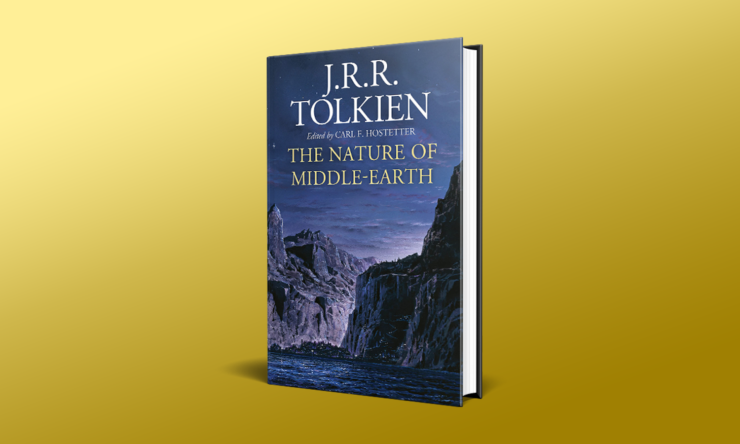
Interesting…I’ll have to check it out. I remember much of the metaphysical things about the anuir and their forms seems to be discussed in Morgoth’s Ring or other sources. I’m thinking about what Tolkien refers to as unmaiar (fallen maiar), iirc. At least that about not being able to easily abandon or shift their manifested form due to their fallen nature and having invested so much of their natural power in and through their physical forms. In fact, I think I remember indications that some of the early orc-chieftains were some of these unmaiar. The greatest of these fallen Anuir maintained the ability to ‘walk unclad’ or shift their form due to their natural strength and potency they had in the beginning (Melkor & Sauron), but soon lost these abilities due investing so much of their native strength in external agencies (the very substance of Arda and his many monstrous corruption in Melkor/Morgoth’s case, and the One Ring and loss of his physical form and power invested in it during the fall of Numenor in Sauron’s case).
I definitely prefer “the more thoroughly realized earlier cosmology of Arda in The Silmarillion” to these later, pseudo-scientific musings. It may not line up with what we now know about the creation of the Earth and Sun and Moon, but it makes for a much more charming story.
@2, To paraphrase something from Life of Pi, I prefer the story with the tiger too. Personally I think the more Tolkien tried to fit his myth with science the more holes there would have been in the myth unless it’s something like “Eru Iluvatar squeezed the gases together until they burned hot enough to give light”.
Regarding the Fall (or not Fall) of Elves, I’d always read their departure from Valinor as their Fall, and honestly this just reinforces it:
I’ve always understood “man’s first disobedience” to be the cause of the Fall in Judeo-Christian mythology, not rejection of God. And “Those that did not [return and seek pardon], even if not personally slayers, must share the blood guilt,” just screams Original Sin to me.
Definitely checking this out, I can always pick and choose what I want to be canon.
Wow, thank you for this review. Probably the best review I have ever read. You cover the book completely and make the material far more interesting than it probably is. You walk a perfect line between humor and reverence. My copy hasn’t arrived yet, but this review tells me what I need to know and offers more than I will ever understand. I can’t wait to page through this book and I will appreciate it more because of this review.. Thank you!
@1, yeah, I do get into the discussion of the Orcs who might have been a form of Maiar (though I don’t use the term unmaiar, what book are you getting that from? not Morgoth’s Ring) in my discussion of Orcs from the History of Middle-earth books: https://www.tor.com/2021/06/10/tolkiens-orcs-boldog-and-the-host-of-tumult/ But even there, as in this book, it’s hard to call any of it final.
@2 Oh, I’m with you. I love the more mythological origin of Sun and Moon via the fruit and flower of the Two Trees. But I do appreciate Tolkien’s desire to make everything work together, even if it was basically impossible to do.
@@.-@ Thanks for the kind words, Eric, but I wouldn’t say anything here is “far more interesting than it probably is.” When you pull out passages and excerpts, it loses some of its poetic power. And even though a lot of what’s written in this book comes from Tolkien’s own notes (and therefore he didn’t always apply his most thoughtful prose), it’s still great.
+1 for the Rush reference.
There are some missing letters in this entry. In some others there is too much bold text.
@7 – Fixed, thanks!
This review is excellent; one random fact that you omit that I was excited to discover is how much further east Cuivienen was from the Sea of Rhûn. Anyone like me who has always loved Middle-earth map-making (anyone remember Peter Fenlon’s maps for the ICE rpg?) will find this an exciting discovery!
@9 Oh, there’s lots that was “omitted” here on purpose. Like the sheer amount of time involved in Elf-gestation! I didn’t want to let this review be as long as my usual deep-dive articles.
The revelation that stood out for me was that the leaders of the Great Journey (Ingwe, Finwe, and Elwe) were fifth generation Elves (at least). The really old Elves, the ones that awoke at Cuivienen, thought that moving to Aman was a terrible idea – our lawns are just fine here, thank you – and they and their followers became the Atari.
I wish we’d seen something from the viewpoint of the Atari. Those guys get dumped on throughout the entire legendarium. When a self-designated “High Elf” wants to insult another Elf, he calls him a “Dark Elf”. But too many of the “High Elves” are massive dicks.
@11 The first generation Elves became Atari? That is a Wii bit of a revelation
@11; @12
The name reflects the fact they lost the opportunity to live in the Blessed Realm because they wouldn’t stop playing addictive games.
Spell check error. Yeah, that’s the excuse.
(But it’s too good not to leave.)
I suppose the next Tolkien papers book (which I expect will be all the highly technical Elvish linguistic stuff) will explain what the meaning of “tra-la-la-lally” is.
Dear Mr. LaSala, I thoroughly enjoyed your article, reviewing (former Lambengolmo) Carl Hostetter’s The Nature of Middle-earth. I thought the injection of humour into the review — and into the book’s subject matter — here and there, was a nice touch. Arda can be a very fraught kind of place! How nice, then, to be re-introduced to it, courtesy of dawdling, breeding farmer Elves, and stinky evil Maiar, and leaping lopoldi, and laidback Númenórean bears.
I need to have this book, under the tree, this Christmas! So sad, though, that this might be one of the last books to ever introduce to us any more of JRR Tolkien’s original writings. But let’s not dwell too much upon that eventuality. Thank you and cheers.
Great piece from Jeff as usual. Ultra-nerdy correction: fëar is the plural of the Quenya term for spirit or soul. The singular is fëa.
It’s worth noting that Carl Hostetter, editor of this volume, is the editor of Vinyar Tengwar, a publication of the (mentioned by Jeff) Elvish Linguistic Fellowship. Starting in the 1980s as a scruffy but earnest fanzine-like publication, VT evolved into a genuine refereed scholarly journal covering Tolkien’s invented languages, and in its most recent issues it published quite a lot of otherwise-unpublished material by Tolkien himself, some of which (like the bit about Elvish ambidexterity) now appears in this book. I’m not sure whether VT is a going concern, but its first 50 issues, 2008 through 2013, can be purchased at Big South American River as a set of five handsome print-on-demand softcovers.
(For “2008 through 2013” above, read “1988 through 2013”. Darn those “long years numberless as the wings of trees.”)
Thanks, Patrick!
Regarding fëa, you mean in the vocab list? Oh yes. I absolutely meant to include both the singular and plural there, as I did with the How the Eldar Half Live and Married With Eldar-children articles.
You know Stephen Colbert will have a copy of this soon if he doesn’t already (if only to cover up his humiliation at not knowing “Derndingle” was where the Ents gathered to ponder Important Events). Granted, he was pretty hard to stump until handed that particular question by the actors who played Merry and Pippin and who are still apparently good friends.
I’m only here for the Rush paraphrasing.
@21 Buenas Noches, Mein Froind! Then my lure worked. :) I daresay I’ve done a fair amount of Rush paraphrasing and deliberate invocations here, even one straight-up tribute to Neil. You can’t be such an awesome intellectual and poetic band and have songs titled “The Necromancer” and “Rivendell” and not come up now and again around these parts.
I will only say that even though I walk through the valley of death I will fëar no evil.
Great review.
Okay, so I’ve read The Silmarillion, Unfinished Tales and I am ready for more. Would it be too much to go into The Nature of Middle Earth or should I go back and start in on the many volumes of The History of Middle Earth?
Re #24
I’d read the posthumous novels next, e.g. The Children of Hurin.
@@@@@ 24. Scott:
Depends what you want to read about. Reading the posthumous novels next isn’t a bad idea. There are 4 books (Return of the Shadow, Treason of Isengard, War of the Ring and Sauron Defeated) in the middle of the HoME books that deal with the History of the Lord of the Rings which is more interesting to me than the first two books (Book of Lost Tales 1 & 2) in the set. I also enjoyed The Lost Road and Other Writings. If you like poetry, then the Lays of Beleriand might be of interest. The People of Middle-Earth has some “stories” that would have fit in quite nicely in Unfinished Tales.
It is perhaps the first sign of corruption among the Numenoreans that they kept dogs as pets and considered cats hostile feral beasts…
Thanks Jeff for the review. I am part of the way through the book. Some of the things that he (Tolkien) tried to introduce, while cool, play real havoc with of his more formed stories. For instance, it is really, really hard to squeeze the Eol, Aridhol, Maeglin story into his new concepts of Elf years vs. solar years. For those who haven’t read, he realized he was making Maeglin a toddler when the Fall of Gondolin happened, unless he changed the story pretty dramatically.
Thanks, Brent. Yes, very little of the new material can be fit neatly into Tolkien’s earlier, more “internally consistent” material, it’s true. While he could theoretically have made it all work out in the end, he simply ran out of time. I’m at least glad we have so much.